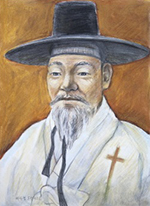 > Hanmi-yo Bae-si Toga > History
> Hanmi-yo Bae-si Toga > History

‘Hanmi-yo Bae-si Toga’
Bae Family, the masters of the beautiful kiln of Korea.
Hanmi-yo Bae-si Toga is a family business with a tradition of 278 years dedicated to producing Onggi and ‘Pure ware’.
The roots of Bae family Onggi trace back to mid-1700s when the Bae family escaped the persecution against Catholic Christians in Korea at the time and hid in the mountains, where they began to make Onggi ware for a living.
Francisco Bae Gwangyeom, the first generation of Hanmi-yo Bae-si Toga became a Catholic Christian just after Catholicism was introduced to Korea in early 1700s. He was the layman among the adherents to the Catholic faith in the Chungcheongdo province where Catholicism was first introduced in Korea. When the nation began to persecute Catholics, Bae moved into the mountains with his family and began making Onggi ware to make a living.
During the religious persecutions against the Catholic Christians in 1800, Bae Gwangyeom was martyred, followed by his first son Augustino Bae Cheongmo who was martyred in 1829 for transcribing Catholic texts. Bae Chihong, the third generation of Hanmi-yo Bae-si To-ga continued on the family lineage of Onggi ware.
Bae Chibong concealed the fact that his family members were martyred, and acquired the skills in ‘Puraedog’ making, which was the considered the most exquisite skill at the time. The skill was then passed down to Bae Gyeongchun, the third generation of the family, and then his son Bae Euiseok, the fourth generation of the family. After Korea’s liberation from Japan on August 15th 1945, the Bae family started producing mainly Oji Onggi ware to meet its rapidly increased demand.
Bae Yoseob, the 5th generation of the Bae family to pass down the family legacy, produced mainly Oji Onggi ware before and after the Korean War in 1950s, until early 1980s when he and his second son Bae Yeonsik, the 6th generation of the family, began producing ‘Puraedog’ again.
The Bae family went through many trial and errors making up for the lost time they didn’t produce ‘Puraedog’, until finally their contribution was recognized and their Pure ware tradition was inscribed as an intangible cultural asset.
Since then, the research in the material and firing technique of ‘Puraedog’ was carried out by Bae Yeonsik, the 6th generation of Hanmi-yo Bae-si Toga, who perfected ‘Pure ware’, an evolved form of the original ‘Puraedog’ fired at 1300℃.
Currently, Hanmi-yo Bae-si Toga is operated by Bae Yeonsik, the 6th generation of the Bae family, and the ‘Pure ware’ Lab is managed by his two daughter Bae Eunkyeong and and Bae Serom, the 7th generation of the Bae family.

1st Bae Gwanyeom